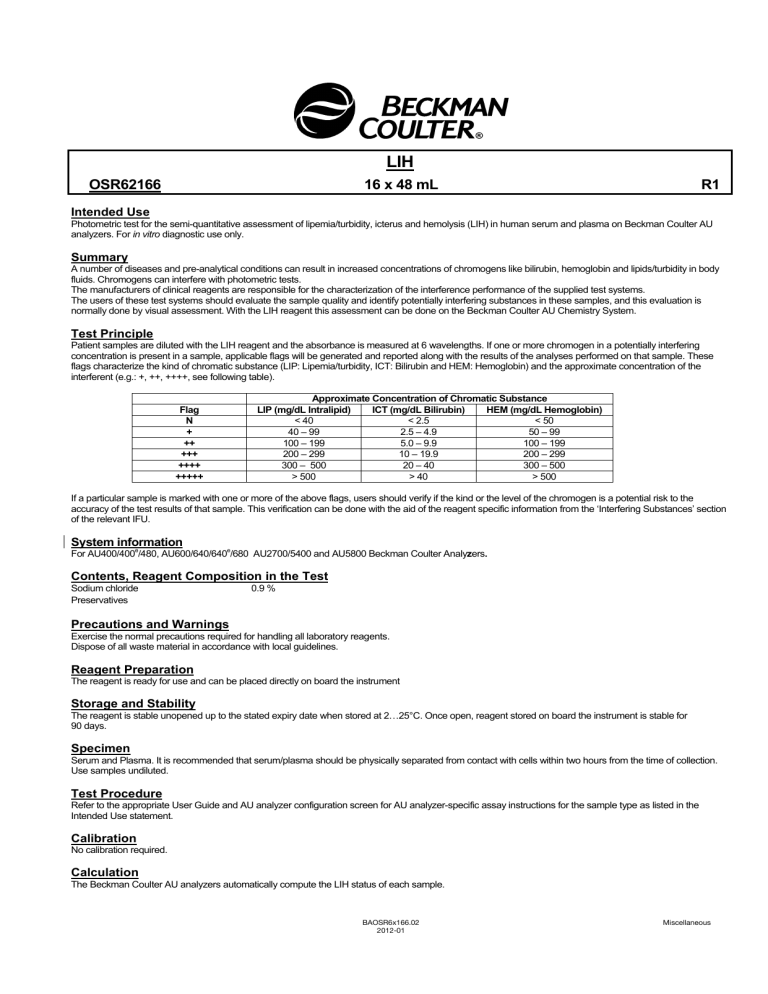
LIH OSR62166 16 x 48 mL R1 Intended Use Photometric test for the semi-quantitative assessment of lipemia/turbidity, icterus and hemolysis (LIH) in human serum and plasma on Beckman Coulter AU analyzers. For in vitro diagnostic use only. Summary A number of diseases and pre-analytical conditions can result in increased concentrations of chromogens like bilirubin, hemoglobin and lipids/turbidity in body fluids. Chromogens can interfere with photometric tests. The manufacturers of clinical reagents are responsible for the characterization of the interference performance of the supplied test systems. The users of these test systems should evaluate the sample quality and identify potentially interfering substances in these samples, and this evaluation is normally done by visual assessment. With the LIH reagent this assessment can be done on the Beckman Coulter AU Chemistry System. Test Principle Patient samples are diluted with the LIH reagent and the absorbance is measured at 6 wavelengths. If one or more chromogen in a potentially interfering concentration is present in a sample, applicable flags will be generated and reported along with the results of the analyses performed on that sample. These flags characterize the kind of chromatic substance (LIP: Lipemia/turbidity, ICT: Bilirubin and HEM: Hemoglobin) and the approximate concentration of the interferent (e.g.: +, ++, ++++, see following table). Approximate Concentration of Chromatic Substance LIP (mg/dL Intralipid) ICT (mg/dL Bilirubin) HEM (mg/dL Hemoglobin) < 40 < 2.5 < 50 40 – 99 2.5 – 4.9 50 – 99 100 – 199 5.0 – 9.9 100 – 199 200 – 299 10 – 19.9 200 – 299 300 – 500 20 – 40 300 – 500 > 500 > 40 > 500 Flag N + ++ +++ ++++ +++++ If a particular sample is marked with one or more of the above flags, users should verify if the kind or the level of the chromogen is a potential risk to the accuracy of the test results of that sample. This verification can be done with the aid of the reagent specific information from the ‘Interfering Substances’ section of the relevant IFU. System information e e For AU400/400 /480, AU600/640/640 /680 AU2700/5400 and AU5800 Beckman Coulter Analyzers. Contents, Reagent Composition in the Test Sodium chloride Preservatives 0.9 % Precautions and Warnings Exercise the normal precautions required for handling all laboratory reagents. Dispose of all waste material in accordance with local guidelines. Reagent Preparation The reagent is ready for use and can be placed directly on board the instrument Storage and Stability The reagent is stable unopened up to the stated expiry date when stored at 2…25°C. Once open, reagent stored on board the instrument is stable for 90 days. Specimen Serum and Plasma. It is recommended that serum/plasma should be physically separated from contact with cells within two hours from the time of collection. Use samples undiluted. Test Procedure Refer to the appropriate User Guide and AU analyzer configuration screen for AU analyzer-specific assay instructions for the sample type as listed in the Intended Use statement. Calibration No calibration required. Calculation The Beckman Coulter AU analyzers automatically compute the LIH status of each sample. BAOSR6x166.02 2012-01 Miscellaneous LIH Method Concordance LIP AU2700 Lipemia Patient serum samples were used to compare the Lipemia Index of this LIH reagent OSR62166 on the AU2700 against a bichromatic turbidity test and against a visual assessment of the sample by three independent observers. The results are summarized in the following tables. Flag Frequency of Lipemia flags +++++ 2 0 ++++ 6 0 1 +ve 3 52 +++ 14 0 1 -ve 288 29 ++ 8 0 0 + 22 1 3 -ve +ve N 476 4 Visual ≤0.0150 0.0151- 0.0401- 0.0801- 0.1201- >0.2000 Assessment 0.0400 0.0800 0.1200 0.2000 Turbidity OD ICT AU2700 Icterus Patient serum samples were used to compare the Icterus Index of this LIH reagent OSR62166 on the AU2700 against the Bilirubin reagent OSR6112 and against a visual assessment of the sample by three independent observers. The results are summarized in the following tables. Flag Frequency of Icterus flags +++++ 4 ++++ 11 3 +ve 7 74 +++ 15 2 1 -ve 283 5 ++ 20 1 10 + 12 5 4 -ve +ve N 449 1 Visual < 2.5 2.505.0010.020.0≥ 40 Assessment 4.99 9.99 19.9 39.9 Bilirubin Concentration (mg/dL) Hemolysis Patient serum samples were used to compare the Hemolysis Index of this LIH reagent OSR62166 on the AU2700 against the Total Hemoglobin reagent OSR6192 (without predilution) and against a visual assessment of the sample by three independent observers. The results are summarized in the following tables. Frequency of Hemolysis flags 0 15 359 < 50 30 26 50-99 24 8 100-199 HEM AU2700 Flag +++++ ++++ +++ ++ + N 10 3 200300299 499 Hemoglobin Concentration (mg/dL) ≥ 500 +ve 1 86 -ve 288 4 -ve +ve Visual Assessment Interfering Substances Results of studies conducted to evaluate the susceptibility of the method to interference were as follows: Lipemia index: no interference up to 40 mg/dL or 684 µmol/L Bilirubin no interference up to 5 g/L hemoglobin ® Bilirubin index: no interference up to 500 mg/dL Intralipid no interference up to 5 g/L hemoglobin Hemolysis index: 40 mg/dL Bilirubin can have a negative effect on the HEM index by a maximum of 2 classes – i.e. a genuine HEM +++ may be reported as HEM + ® 500 mg/dL Intralipid can have a positive effect on the HEM index by a maximum of 1 class – i.e. a genuine HEM + may be reported as HEM ++ Both interference effects are linear with the Bilirubin and Intralipid concentration. Limitations The integrity of all indices should be visually verified if ABN flags are obtained. If severe turbidity, icterus and/or hemolysis is observed consider these samples as LIP+++++, ICT+++++ and/or HEM+++++. If the visual assessment shows no apparent abnormality consider these samples as normal. In rare cases mild hemolysis (20 to 50 mg/dL) may generate ABN flags. LDH/HBDH in these samples may be increased by 10 to 20% Please note that there is a poor correlation between the Lipemia index, or turbidity, of the sample and the triglyceride concentration. Miscellaneous BAOSR6x166.02 2012-01 LIH References • Tietz NW. "Specimen Collection and Processing; Sources of Biological Variation," Textbook of Clinical Chemistry, 2nd Edition, W. B. Saunders, Philadelphia, PA (1994). • National Committee for Clinical Laboratory Standards, Procedures for the Handling and Processing of Blood Specimens, Approved Guideline, NCCLS publication H18-A, Villanova, PA (1990). • Tietz NW. "Clinical Guide to Laboratory Tests," 3rd Edition, W. B. Saunders, Philadelphia, PA (1995). • Henry JB ed. "Clinical Diagnosis and Management by Laboratory Methods," 18th Edition, W. B. Saunders, Philadelphia, PA (1991). • Friedman RB and Young DS. Effects of Disease on Clinical Laboratory Tests, 3rd Edition, AACC Press, Washington, D.C. (1997). • Young DS. Effects of Preanalytical Variables on Clinical Laboratory Tests, 2nd Edition, AACC Press, Washington, D.C. (1997). Manufactured by: Beckman Coulter, Inc., 250 S. Kraemer Blvd. Brea, CA 92821, USA BAOSR6x166.02 2012-01 Miscellaneous
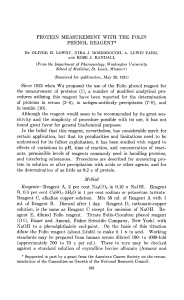
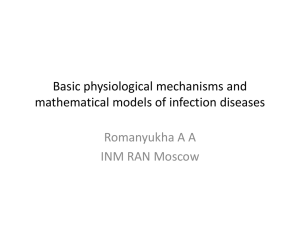

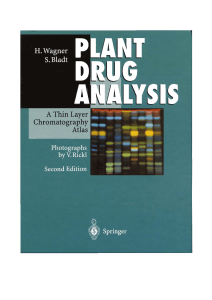
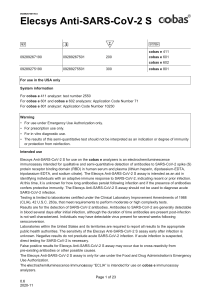
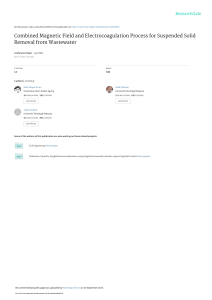
![[Michael C. Pirrung] Handbook of Synthetic Organic(z-lib.org)](http://s1.studylib.ru/store/data/006236139_1-286bb5a91bdd8857ebb85cf974fb798c-300x300.png)
